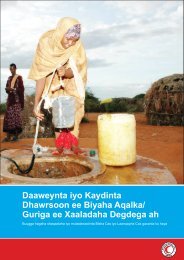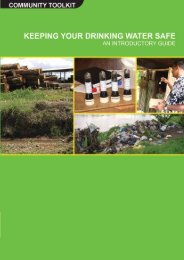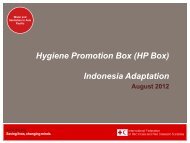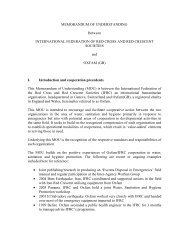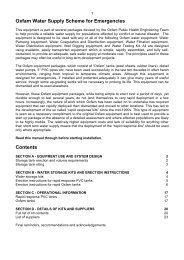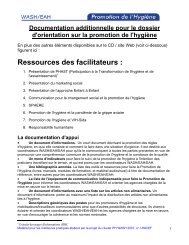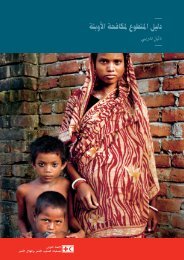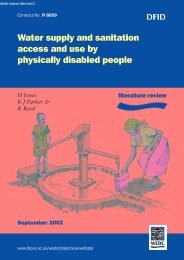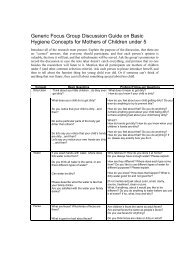Large programmes need to focus. They therefore target only one or two specific conditionsor practices that constitute a particular risk. Examples in water or sanitation programmesare:• safe methods of human excreta disposal• proper h<strong>and</strong>washing habits by all at critical times• only using safe water sources, at least for drinking <strong>and</strong> food preparation• frequent washing of children's eyesFor expansion of reasons why these particular messages are important see Appendix 8.Tailoring the programmeThe people targeted in public health communication are not one homogeneous group.They consist of older <strong>and</strong> younger people, women <strong>and</strong> men, people with different class,ethnic <strong>and</strong> religious backgrounds, living <strong>and</strong> working in different environments. Althoughthe primary targets will be those carrying out the risky practices (e.g. mothers,schoolchildren, child carers for e.g. h<strong>and</strong>washing, adolescent boys who may not usetoilets), it is also important to reach others who can influence how they behave. So,fathers, mothers-in-law, neighbours <strong>and</strong> social contacts are “secondary” targets formessages that may exert peer pressure. Then come the opinion-formers <strong>and</strong> people inauthority in different walks of life. Teachers, religious leaders, government officers,politicians <strong>and</strong> community leaders are the “tertiary” targets for messages which improvetheir underst<strong>and</strong>ing of health impacts <strong>and</strong> other benefits from specific behaviouralchanges. Each group has its own <strong>and</strong> often different interests, responsibilities, skills <strong>and</strong>resources. The nature <strong>and</strong> places of risks, <strong>and</strong> possibilities to reduce risks are alsodifferent. Most importantly, the channels for communication will be different for the differentgroups. Some segmentation is needed with all target groups, whether primary, secondaryor tertiary. Segmenting the user groups is also a repetitive process. It happens in thepreparatory studies, the planning <strong>and</strong> implementation of the strategy, the monitoring <strong>and</strong>readjustment, <strong>and</strong> the final evaluation. Assemblies <strong>and</strong> meetings are not an effective wayfor reaching poor mothers as they seldom go to general gatherings. However, they maywell be an effective way of giving health messages to politicians <strong>and</strong> government officials.McKee describes the process of bringing people together on the basis of their owninterests <strong>and</strong> willingness to act as Social Mobilisation. Unfortunately, in practice, it is notuncommon for social mobilisation to become a form of manipulation whereby some paidstaff in external agencies muster local people <strong>and</strong> groups as volunteers to help them reachtheir internal goals <strong>and</strong> targets. That should be avoided; it is the informed opinions of thegroups that lead to successful programmes.When planning a hygiene promotion programme, defining the answers to six questions iscentral. The answers need to come not just from the health <strong>and</strong> communication specialists,but also from the different user groups in the programme area:• What are the risk practices of the different groups, including as seen by them?• Who are the primary, secondary <strong>and</strong> tertiary target audiences?• What can motivate behaviour change of the target groups?22 <strong>Hygiene</strong> promotion
• What may prevent this change in each target group?• How can different target audiences be reached <strong>and</strong> involved?• How do we measure the effects, <strong>and</strong> the cost-effectiveness, of the programme?There are many different reasons why people want better hygiene facilities <strong>and</strong> practices:to live in a cleaner environment, more convenience, less work, more status, self-respect,raised value of the house, better life for children, more safety at night, more safety forwomen <strong>and</strong> girls, more privacy, lower risk of witchcraft, less opportunity for adultery, lowerwalking distance, protection from bad weather, solving problems of sick or elderly relatives(parents), improving sanitation or hygiene provisions as a condition for marriage, followingan example by neighbours or admired others, responding to pressure from others, meetingneeds of visiting relatives, etc. Different groups have different reasons. Finding out whatmessages are best for which groups helps design better programmes.4.3 Community-managed, locally specific hygiene promotionprogrammesGovernments <strong>and</strong> others concerned with inadequate hygiene may also want to develop thecapacities of local governments <strong>and</strong> groups to plan <strong>and</strong> manage their own actionprogrammes for better hygiene practices <strong>and</strong> conditions in their locations. In communitymanagedhygiene promotion programmes, a representative local organisation managesthe planning <strong>and</strong> implementation of local hygiene promotion activities. The programmemay have a range of objectives:• Immediate: to mobilise community resources <strong>and</strong> build capacities to identify <strong>and</strong>measurably reduce risky conditions <strong>and</strong> practices <strong>and</strong> strengthen positive ones ofpeople's own choice.• Longer-term: to reach <strong>and</strong> maintain a level of hygiene that is acceptable to the women<strong>and</strong> men of the community <strong>and</strong> that cuts out, or significantly reduces, the previouslyexisting risks of disease transmission.• Ultimate: to empower communities to solve their own hygiene problems <strong>and</strong> reducethe local incidence of, <strong>and</strong> mortality from, water <strong>and</strong> sanitation related diseases.In addition to direct hygiene <strong>and</strong> health related objectives, there may also be widerdevelopmental objectives: strengthen the sense of community <strong>and</strong> community action,increase the analytical, managerial <strong>and</strong> problem solving capacities of communitymembers, reduce inequalities between genders <strong>and</strong> social <strong>and</strong> economic groups, enhanceself-confidence <strong>and</strong> self-respect of various groups, including those that are disadvantagedor marginalised.Community-managed hygiene promotion programmes are best undertaken with relativelywell-organised communities with active leaders <strong>and</strong> their own resources. The communitiesneed not be homogeneous <strong>and</strong> well off, but unity <strong>and</strong> solidarity have to be sufficientlystrong. Otherwise, interested communities may first need to demonstrate that they canform active organisations <strong>and</strong> effectively manage some form of locally initiated change. A‘community’ may vary from a single neighborhood or village to administrative clusters<strong>IRC</strong> <strong>International</strong> <strong>Water</strong> <strong>and</strong> <strong>Sanitation</strong> <strong>Centre</strong> 23
- Page 2: Please note that the TOPs are a web
- Page 7 and 8: 1. Hygiene PromotionWhat do you kno
- Page 9 and 10: 2. Why hygiene promotion matters2.1
- Page 11 and 12: • The costs of inaction can be hi
- Page 13 and 14: 3. Learning from experiences and re
- Page 15 and 16: • Hygiene Improvement Framework (
- Page 17 and 18: groups, and facilitators of partici
- Page 19 and 20: The diagrams are taken from McKee
- Page 21 and 22: • Food, utensils and food prepara
- Page 23: Guides for developing hygiene promo
- Page 27 and 28: areas, slabs and sanplats for latri
- Page 29 and 30: often not taken seriously and their
- Page 31 and 32: IIIIIIIVVInputsProcOutpEffectiImpae
- Page 33 and 34: over for reasons of hierarchy, e.g.
- Page 35 and 36: 5. Case studiesOn the following pag
- Page 37 and 38: The Project recognises the importan
- Page 39 and 40: almost all cases been exceeded, as
- Page 41 and 42: skin diseases, HIV/AIDS and tubercu
- Page 43 and 44: understanding of the importance of
- Page 45 and 46: councils (JSCs) are associations of
- Page 47 and 48: o through a schools programme, with
- Page 49 and 50: outputs and outcomes are focused mo
- Page 51 and 52: Harvey, Eric, Shadrack Dau, Alana P
- Page 53 and 54: programmes more effective. The obje
- Page 55 and 56: scale. Comparison is on approach, l
- Page 57 and 58: Hygiene Behaviour Network, in Globa
- Page 59 and 60: WHO - World Health Organizationhttp
- Page 61 and 62: Tel: (703) 247-8730Fax: (703) 243-9
- Page 63 and 64: Manila, PhilippinesTel: +632 911-57
- Page 65 and 66: TOP Courses and conferencesCREPA, B
- Page 67 and 68: TOP ReferencesBoot, Marieke T. and
- Page 69 and 70: TOP Quiz on Hygiene PromotionTry it
- Page 71 and 72: Question 4All the interventions wil
- Page 73 and 74: Then you may decide that this paper
- Page 75 and 76:
Appendix 1. Hygiene promotion manua
- Page 77 and 78:
2. Target specific audiences.These
- Page 79 and 80:
Appendix 4. WASH facts and figures1
- Page 81 and 82:
Research)18: (IHE Newsletter, Janua
- Page 83 and 84:
Appendix 6. Preventive measuresMeas
- Page 85 and 86:
Appendix 8. Some key objectives for
- Page 87 and 88:
Appendix 9. Participatory tools and
- Page 89 and 90:
Appendix 10. The PHAST approachFor
- Page 91 and 92:
Planning techniques are used to sim
- Page 93 and 94:
While sensitive topics are often be
- Page 95:
About IRCIRC facilitates the sharin



